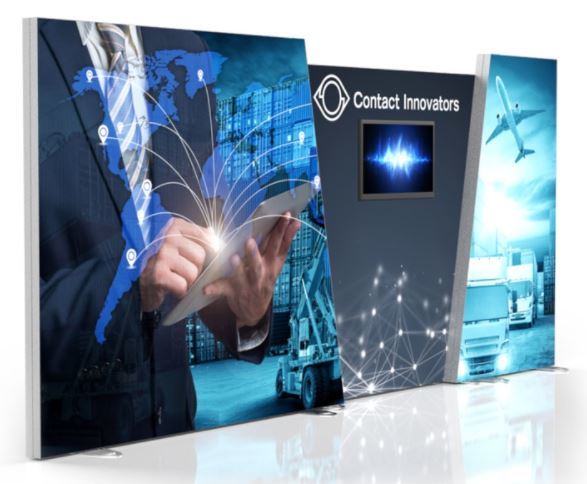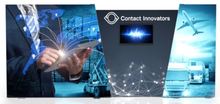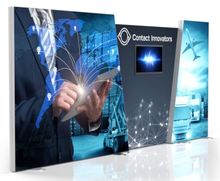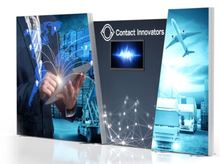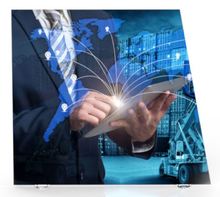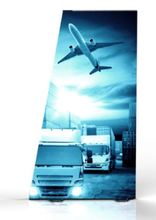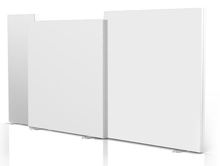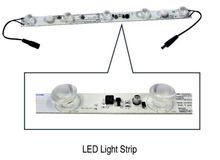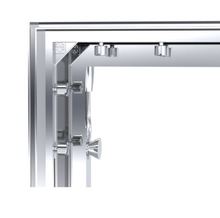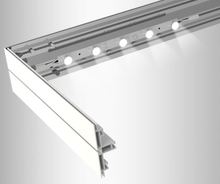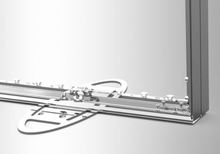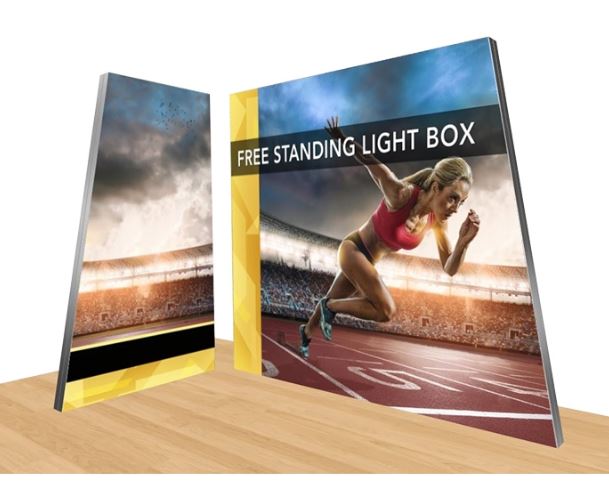Portable LightBoxes
Create a stunning light show with our freestanding Portable lightbox package. Includes LED lighting to back light your graphics, SEG graphic for the front, white backer for the back of your display, and powder coated frames.
This 10 x 20 light box display is built with three separate hardware sections; a 9ft angled light box, a 6ft angled light box, and an 8ft angled light box. These three pieces can be purchased separately, or they can be purchased together, as a 20ft wide light box kit. The pieces can obviously also be used in different combinations, creating unique looks for your light box display.
The backlighting uses LEDs for maximum durability.
- All products include:
- - (1) Dye Sub Printed Full Color Fabric Graphic
- - (1) Fabric backer
- - (1) Large format light box frame
- - (1) Large shipping cases with wheels
- - (1) Torx wrench
- - (1) Allen wrench
LED light strip information:
- - Each Module contains five LED lights
- - Input voltage (V): DC24±0.5
- - Power Consumption (W): 10W
- - Material:AL base plate
- - Specification (mm): 360mm*23mm*16mm
- - Lamp type:Epistar
- - Color temperature (K):3000K~7000k
- - Beam angle(*):20*60* / 10*45*
- - Luminous flux (lm):≥750LM
- - Lifetime:≥20000H
- - Protect rate (IP):IP25
Wheeled hard shipping case included.
Elevate Your Branding: An End-to-End Guide on the Portable Lightbox
It’s no secret that marketing has been one of the trendiest and most effective forms of brand awareness. Regardless of the wealth of advertising sources and the number of new ones that crop up with the advent of technology, marketing continues to thrive.
Lightboxes lure in a greater customer base and trigger a notable rise in sales. It’s through this marketing medium that you can reach an increased number of people and leave a lasting impression of your brand. Nowadays, this type of marketing is renowned in various brands and has proved to be quite fruitful.
With that being said, if you’re interested in revamping your branding technique, then you’ve come to the right place. In this end-to-end guide on the portable lightbox, we’ll explore everything you need to know about lightboxes to step up your marketing skills by a few notches.
What Is A Lightbox?
It’s a sign cabinet with illumination, delivering constant visibility. Lightboxes are typically used in the signage world and are an excellent way of promoting the logo of your brand.
Lightbox displays are made from a combination of sturdy and durable materials that can handle anything thrown at them. They range from Lexan and aluminum materials to acrylic. As a bonus, these materials are a sight for sore eyes and serve as the ideal promotional tools.

Custom Exhibit with LED Lit Shelving and Backlit SEG Fabric Lightbox
Types of Lightboxes
Contrary to what a multitude of people assume, there’s more to lightboxes than taking a generic poster and positioning it in front of a light source.
When choosing a portable lightbox, remember, there are different types available. The option you settle for is based on the environment in which you intend to set it up.
LED Direct Backlit
If you’re on the quest for an evenly lit and bright way of illuminating a graphic surface, then an LED Direct Backlit display is your best bet. In this variation of a portable lightbox, LED light strips are positioned horizontally or vertically in rows, right behind the box’s graphic surface.
In most branding scenarios, backlighting with these strips is one of the most foolproof ways of crafting eye-catching signs which is the endgame. Granted, it may not be the brightest way of illuminating a surface.
LED Direct Backlight lightboxes have sufficient lighting and are more economical than fluorescent counterparts. But, to match the evenness and brightness of fluorescent direct backlit display lightboxes, a box with LED lights needs additional rows of strips. And, it consumes just as much energy and generates almost as much heat.
Most scenarios don’t require matching the effects of fluorescent lightboxes. Moreover, when the LED strips are more spaced out compared to fluorescent tubes, there’s significant energy saving.
LED produces a uniform and beautiful outcome with a graphics surface whose brightness is sufficient for most indoor events or retail settings. Keep in mind that most direct backlight lightboxes require a depth that ranges from 4 to 5 inches.
Fluorescent Backlit
Once upon a time, nothing could match the uniform brightness that radiated from the rows of long fluorescent tubes. It was due to how evenly internally diffused tubes could emanate light. Now, LED technology is superior to fluorescent lighting when it comes to brightness and is every bit as even across a sign’s surface.
LED Edge-Lit
It’s unarguably the most economical way of illuminating a lightbox. In this type of portable lightbox, LED lights are positioned along the box’s perimeter behind the graphic surface.
LED Edge-lit lightboxes, use a fraction of the wattage that the Direct Backlit counterparts consume. Thus, it’s an energy-efficient option to consider. The amount of heat emanated by any type of lighting is considerable upon factoring in that each joule of heat needs an energy watt to cool down a room.
Every energy unit, regardless of the purpose it’s serving (cooling or lighting) costs money. The only reduced level of uniformity and brightness from LED Edge-lit lightboxes compared to the Direct Backlit counterparts is negligible.
Animation Light Boxes
The newest advance in LED fabric light boxes, an animation light box uses a ladder array of LEDs inside the light box. These LEDS are programmable, so that they turn on and off as needed to help simulate movement. Learn more about animation light boxes here.
Buying Guide: How to Choose the Best Portable Lightbox
Here’s a breakdown of some criteria to factor in when choosing a lightbox to permit an informed decision. After all, the last thing you need is to come out of pocket for a product that leaves you dissatisfied.
Rigidity and Durability
Each manufacturer engineers their frames via materials of varying sturdiness and longevity. As with everything else in life, you get what you pay for. So, the cheaper lightboxes are constructed with softer aluminum that’s less durable.
Aluminum also tarnishes relatively fast and is susceptible to damage from scratches and dents. Bearing that in mind, choose a portable lightbox that’s built from aluminum with a specification of 6063. It provides superior structural integrity and is scratchproof, which is essential because you’ll be transporting it from one event to another.
Availability
Consider whether the manufacturer has the hardware, extrusion, and LED lights, and other handy accessories in stock. Moreover, are there extrusion options that cater to the different scenarios, for instance, one-sided, free-standing, or double-sided?
Can the damaged or lost parts of the lightbox be easily replaced? Are there quick shipping alternatives available? Can several quantities be shipped together? After all, the last thing you need is a manufacturer that dabbles in lightboxes.
Print Quality
Dye-sublimation printing is your best bet. It guarantees the colors are infused into the fabric as opposed to simply being printed on the surface. You’ll find a myriad of suppliers bragging about ‘fabric printing.’
Remember, it’s not always dye-sublimation that needs two steps; firstly printing to a paper material and secondly, infusing heat on the image to the fabric. Inquire about the printer’s age to ensure it’s not more than two years old.
Anything older than that implies that the printer’s resolution is average. As is the case with clothing, the fabric quality differs, which is a non-factor if the graphics are throwaway, and the resolution is insignificant.
Packaging
It’s easy to assume that your lightbox will arrive in topnotch cases and packaging for enhanced portability. Unfortunately, this is rarely the case. A multitude of manufacturers uses one-way disposable shipping materials, which means your lightbox arrives undamaged.
The challenge arises when you need to transport it from one event to another, and there’s nothing to keep it organized and protected from damage. So, ensure you choose a product that comes with a heavy-duty case. Avoid those that only include shrink-wrap, cardboard, and thin foam as al 3 will be rendered useless after one use. Granted, you may need to shell out extra bucks. But, it’s an investment that keeps giving one event, assembly, and disassembly, after another.
Assembly and Dismantling
A multitude of people usually overlooks the assembling and dismantling process of a portable lightbox. It’s a grave mistake that usually catches up with them after the first use. While some lightboxes require a bag of loose parts and tools, others come with press-button connectors.
Other lightboxes are tool-less for the most part. However, the hardware is unnecessarily complicated or cumbersome. To avoid resigning yourself to this fate, an assembly video before purchasing will do you good.
Even if you don’t plan to assemble it, can you follow the instructions to the letter on how to put it together in a fairly short timeframe, if the need arises? Keep in mind that time is money, more so on the event floor. The last thing you want is unwarranted surprises at your tradeshow. A well-designed portable lightbox that won’t make you sweat, quite literally, is a worthwhile investment. So, conducting your due diligence will certainly pay off.
Material
When choosing the material to print on, here’s a breakdown of your safest bets.
Backlit Paper
A thin and translucent Bristol (7pt) is uniquely layered to keep warming in humid conditions, at bay. Backlit paper is then printed on the Latex roll or UV curing to roll. Note that this paper is thin and budget-friendly, thus making it the go-to option for settings such as bus shelters.
Printable Film
Thin translucent plastic sheets, ranging from polypropylene to styrene, make durable lightboxes for entrance displays. The printable film is printed via screen-print.
Photographic Transparency Film
Transmissive and photographic media is typically known as ‘translites.’ It’s this polyester media that can be imaged via an RGB laser system, for instance, a Durst Lambda. And, given its photographic nature, the image is of topnotch quality.
As with everything else in life, you get what you pay for. So, this excellent image quality comes at a price. Translites prints depict low light-fastness upon exposure to sunlight. Therefore, they are typically more suitable for indoor use in high-end retail stores or events that revolve around fashion, cosmetics, and jewelry.
Inkjet Backlit Film
Via strikingly similar polyester film, such as translites, inkjet film backlit images are layered with an ink-receptive layer in place of photographic emulsion. Printed with a high-resolution latex printer, this media closely rivals translites when it comes to quality.
The only difference is that it’s not only cheaper but also has remarkable light-fastness, which makes it perfect for outdoor and indoor use.
Fabric/Vinyl Backlit
It revolves around media that’s printed on a grand-format inkjet printer with latex or solvent ink. Vinyl or fabric backlight is typically used for sizes that exceed what can be imaged with large-format or photographic inkjet films.
Fabric and vinyl backlit frames contain built-in tensioning systems that keep the backlit held flat to prevent wrinkles. With excellent functionality, it can be difficult to tell they’re not sturdy sign faces. Regardless of the size, this large backlit is easy to roll and ship, thus making it an ideal option for retail branding.
Why Use An LED Lightbox Over the Fluorescent Counterparts?
Conventional illuminated marketing utilizes a fluorescent photo lightbox. But, the advent of technology has ushered in a superior way to market your brand in public settings; via the use of LED lightboxes that come with the following perks.
1. Reduced Power Consumption
Light Emitting Diodes (LEDs) have lower energy consumption compared to fluorescent counterparts. They consume a fraction of the electricity needed to power fluorescent lights to generate superior lighting. Given that a lightbox usually stays on for as long as need be, it’s in your best interest to keep the power bill as low as possible.
2. Longer Life Expectancy
LED lightboxes can last for anywhere between 35,000 and 50,000 hours, which is significantly more than the fluorescent counterparts that can be used for 10,000 to 15,000 hours. An LED lightbox gets to the end of its lifespan with minimal maintenance needed, whereas the fluorescent options require constantly replacing the lights with new ones for the same duration.
3. More Eco-friendly
Reduced power consumption means a lower carbon footprint. In turn, it ushers in more eco-friendly operations. An LED lightbox can achieve this goal without compromising on the output and quality of your marketing efforts.
Your brand gains sustainability on a practical level. Moreover, you can accomplish social responsibilities, concurrently. Contrarily, fluorescent lightboxes are filled with heavy metals such as mercury that raise safety concerns.
The likelihood of breakage is more with fluorescent tubes than the LED counterparts. The need to replace broken or damaged fluorescent lightboxes ushers in increased waste and pollution.
4. Increased Versatility
LED lightboxes lack the form restrictions of the conventional fluorescent counterparts and are usually smaller. Therefore, they can be used in a barrage of ways compared to fluorescent lightboxes.
LED lightboxes typically come in ultra-thin designs, thus making them space efficient at your workplace or event. As a result, this leaves more room for foot traffic and to showcase more products. Their sleek look is ideal for infusing an elegant and contemporary aesthetic.
The sturdiness of these lightboxes allows you to position them outside your store or event without worrying about them getting damaged as you show off your product photography. It’s easier to lure in passers-by to with a uniquely-designed, vibrantly-colored LED lightbox at the entrance.
Elevate Your Branding: An End-to-End Guide on the Portable Lightbox
With a portable lightbox, you can lure in more customers compared to the non-illuminated counterparts and consequently drive more sales. Therefore, regardless of the cost, this kind of portable photo studio is a prudent investment for any brand seeking to boost awareness and sales revenue. Give us a shout and we'll be happy to walk you through the many types of portable lightboxes we have available for your shows and events.

